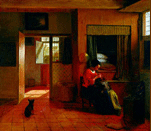










16.
Downward Mobility: Royal and Noble
Women Negotiating Lower Status
Organizers:
Description:
In the rigorous hierarchy of early modern society, upward mobility was accounted
a result of individual talent and hard work, luck or fate, good lordship and
divine blessing. Downward mobility was a result of the absence of these factors,
and those who suffered were pitied, scorned or disparaged. However certain
high status women elected downward mobility and they are the subjects of this
workshop.
The workshop will open with three brief examples of downward mobility for
British queens and English and Italian noblewomen. We hope participants will
also present cases of downward mobility from their studies of any social group
or geographic area. Discussion will include motives for and effects of these
decisions to spark the discussion on which the workshop will be primarily
based.
We would like to consider questions about women’s agency in contracting
second marriages. What were the consequences for a woman’s status? How
were families affected, including children of the first marriage? How did
early modern patriarchal practices adapt to unequal matches where the woman
had superior wealth & status?
Were there advantages for these women who elected not to remain widows? Queen
Catherine’s marriage to Owen Tudor began the dynasty; did it affect
social norms?
Did women who married below their status do so for love? Or did they so marry
in order to retain their own political control or standing in a patriarchal
society that usually enforced a husband’s control over his wife? We
should also consider the Italian data suggesting that women--especially widows--played
an active role in the dowry strategies adopted by elite families. In an Italian
provincial urban elite, was “downward mobility” only indicated
by the relative wealth of the husband and wife? Different branches of a family
enjoyed different levels of status, and how might a widow, especially, negotiate
her options in choosing a second husband? What factors—other than status
and wealth--might influence her choice?
Kristen Walton: During the sixteenth century in England and Scotland, queens were in a unique position with regard to their marital status. If a woman were a queen, she could not marry in order to increase her status or be upwardly mobile, but the patriarchal structure of the day encouraged women to marry either their equals or betters. As young girls, princesses would not be able to choose their own husbands, but a dowager queen, such as Mary Tudor, the French queen, would often make her own choice as to her next marriage partner. In addition, an adult single queen regnant had the power to make her own decisions regarding her marriage choice. Although Elizabeth I remained single, and Mary I married an equal, Mary Stewart, queen of Scots, married Henry Darnley, who was not a prince in his own right. In this workshop, Kristen Walton will be addressing the question of English and Scottish queens who married beneath their status, including Mary Tudor, Katherine Parr, Margaret Tudor, and Mary Stewart. .
Barbara Ann McCahill: Of 253 English women who enjoyed noble titles, 1485-1547, 100 married more than once. Seventy-three of them married twice, twenty-four three times and three women married four husbands each. In terms of status within the peerage, sixty-three women married barons, the first level. ( Three married kings and are part of Kristen Walton’s group.) Of the thirty-four ladies whose rank was vicountess or higher and who married more than one time, fifteen married men without noble rank as their final husbands. We will be considering particularly those fifteen women from the higher ranks of the nobility who elected to disparage their honor by these marriages. Their situations illuminate the royal, social, political and financial pressures on high noble widows. Examples include duchesses who married their servants, countesses who married younger brothers of peers and dowagers whose first husbands were executed.
Alison Smith: A study of noblewomen in renaissance Verona (15th century through mid-17th century), based largely on wills and census data of households, focuses on the social, economic and political behavior of married/ widowed noblewomen. Several examples of downwardly mobile women have emerged from the documents, but their decisions to marry below themselves do not appear to reflect a single identifiable strategy. In this workshop I will explore various strategies that women might have adopted that would in fact result in downward mobility. Another piece of our discussion might revolve around what these women did after their downward mobility began--how they negotiated issues of status, place, widowhood, and marriage of their own children. Because of the rich census data in Verona, it is possible to trace these trans-generational changes in certain cases. The Veronese case also merits comparison to Venice, where "downward mobility"--marriage to a "citizen"--was a time-honored strategy, and one that could be used to avoid sending a daughter into a convent.
List of Readings:
Total readings required for the seminar (>20 pp) will be selected from:
|
|
|
||||||
|
|
 |
 |
|
||||
 |
|
 |
|
||||
|
|
|
||||||
|
|
|
||||||
 |
|
||||||
|
|
|
||||||
| |
|
||||||
 |
|
||||||
 |
|
||||||
 |
|
||||||
 |
|
||||||
|
|
|
||||||
|
|
 |
|
|
||||
 |
|
||||||
|
|
|
|
|
|
|
|
|